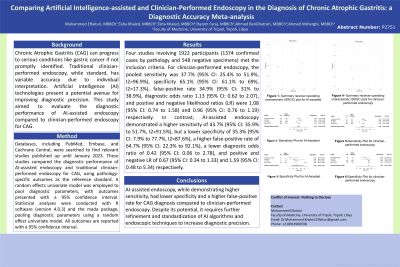Monday Poster Session
Category: Stomach
P2751 - Comparing Artificial Intelligence-Assisted and Clinician-Performed Endoscopy in the Diagnosis of Chronic Atrophic Gastritis: A Diagnostic Accuracy Meta-Analysis
Monday, October 23, 2023
10:30 AM - 4:15 PM PT
Location: Exhibit Hall

Has Audio
- ME
Muhammed Elfaituri, MBBCh
University of Tripoli
Tripoli, Tripoli, Libya
Presenting Author(s)
Award: Presidential Poster Award
Muhammed Elfaituri, MBBCh, Taha Khaled, , Hazem Faraj, MBBCh, Ahmed BenGhatnsh, MBBCh, Ahmed Msherghi, MBBCh
University of Tripoli, Tripoli, Tripoli, Libya
Introduction: Chronic Atrophic Gastritis (CAG) can progress to serious conditions like gastric cancer if not promptly identified. Traditional clinician-performed endoscopy, while standard, has variable accuracy due to individual interpretation. Artificial intelligence (AI) technologies present a potential avenue for improving diagnostic precision. This study aimed to evaluate the diagnostic performance of AI-assisted endoscopy compared to clinician-performed endoscopy for CAG.
Methods: Databases, including PubMed, Embase, and Cochrane Central, were searched to find relevant studies published up until January 2023. These studies compared the diagnostic performance of AI-assisted endoscopy and traditional clinician-performed endoscopy for CAG, using pathology-specific outcomes as the reference standard. A random effects univariate model was employed to pool diagnostic parameters, with outcomes presented with a 95% confidence interval. Statistical analyses were conducted with R software (version 4.0.3) and the mada package, pooling diagnostic parameters using a random effect univariate model. All outcomes are reported with a 95% confidence interval.
Results: Four studies involving 1922 participants (1374 confirmed cases by pathology and 548 negative specimens) met the inclusion criteria. For clinician-performed endoscopy, the pooled sensitivity was 37.7% (95% CI: 25.4% to 51.9%, I2=96.9%), specificity 65.1% (95% CI: 61.1% to 69%, I2=17.3%), false-positive rate 34.9% (95% CI: 31% to 38.9%), diagnostic odds ratio 1.13 (95% CI: 0.62 to 2.07), and positive and negative likelihood ratios (LR) were 1.08 (95% CI: 0.74 to 1.58) and 0.96 (95% CI: 0.76 to 1.19) respectively. In contrast, AI-assisted endoscopy demonstrated a higher sensitivity of 43.7% (95% CI: 35.9% to 51.7%, I2=91.5%), but a lower specificity of 35.3% (95% CI: 7.9% to 77.7%, I2=87.6%), a higher false-positive rate of 64.7% (95% CI: 22.3% to 92.1%), a lower diagnostic odds ratio of 0.42 (95% CI: 0.06 to 2.78), and positive and negative LR of 0.67 (95% CI: 0.34 to 1.33) and 1.59 (95% CI: 0.48 to 5.34) respectively.
Discussion: AI-assisted endoscopy, while demonstrating higher sensitivity, had lower specificity and a higher false-positive rate for CAG diagnosis compared to clinician-performed endoscopy. Despite its potential, it requires further refinement and standardization of AI algorithms and endoscopic techniques to increase diagnostic precision.
Disclosures:
Muhammed Elfaituri, MBBCh, Taha Khaled, , Hazem Faraj, MBBCh, Ahmed BenGhatnsh, MBBCh, Ahmed Msherghi, MBBCh. P2751 - Comparing Artificial Intelligence-Assisted and Clinician-Performed Endoscopy in the Diagnosis of Chronic Atrophic Gastritis: A Diagnostic Accuracy Meta-Analysis, ACG 2023 Annual Scientific Meeting Abstracts. Vancouver, BC, Canada: American College of Gastroenterology.
Muhammed Elfaituri, MBBCh, Taha Khaled, , Hazem Faraj, MBBCh, Ahmed BenGhatnsh, MBBCh, Ahmed Msherghi, MBBCh
University of Tripoli, Tripoli, Tripoli, Libya
Introduction: Chronic Atrophic Gastritis (CAG) can progress to serious conditions like gastric cancer if not promptly identified. Traditional clinician-performed endoscopy, while standard, has variable accuracy due to individual interpretation. Artificial intelligence (AI) technologies present a potential avenue for improving diagnostic precision. This study aimed to evaluate the diagnostic performance of AI-assisted endoscopy compared to clinician-performed endoscopy for CAG.
Methods: Databases, including PubMed, Embase, and Cochrane Central, were searched to find relevant studies published up until January 2023. These studies compared the diagnostic performance of AI-assisted endoscopy and traditional clinician-performed endoscopy for CAG, using pathology-specific outcomes as the reference standard. A random effects univariate model was employed to pool diagnostic parameters, with outcomes presented with a 95% confidence interval. Statistical analyses were conducted with R software (version 4.0.3) and the mada package, pooling diagnostic parameters using a random effect univariate model. All outcomes are reported with a 95% confidence interval.
Results: Four studies involving 1922 participants (1374 confirmed cases by pathology and 548 negative specimens) met the inclusion criteria. For clinician-performed endoscopy, the pooled sensitivity was 37.7% (95% CI: 25.4% to 51.9%, I2=96.9%), specificity 65.1% (95% CI: 61.1% to 69%, I2=17.3%), false-positive rate 34.9% (95% CI: 31% to 38.9%), diagnostic odds ratio 1.13 (95% CI: 0.62 to 2.07), and positive and negative likelihood ratios (LR) were 1.08 (95% CI: 0.74 to 1.58) and 0.96 (95% CI: 0.76 to 1.19) respectively. In contrast, AI-assisted endoscopy demonstrated a higher sensitivity of 43.7% (95% CI: 35.9% to 51.7%, I2=91.5%), but a lower specificity of 35.3% (95% CI: 7.9% to 77.7%, I2=87.6%), a higher false-positive rate of 64.7% (95% CI: 22.3% to 92.1%), a lower diagnostic odds ratio of 0.42 (95% CI: 0.06 to 2.78), and positive and negative LR of 0.67 (95% CI: 0.34 to 1.33) and 1.59 (95% CI: 0.48 to 5.34) respectively.
Discussion: AI-assisted endoscopy, while demonstrating higher sensitivity, had lower specificity and a higher false-positive rate for CAG diagnosis compared to clinician-performed endoscopy. Despite its potential, it requires further refinement and standardization of AI algorithms and endoscopic techniques to increase diagnostic precision.
Disclosures:
Muhammed Elfaituri indicated no relevant financial relationships.
Taha Khaled indicated no relevant financial relationships.
Hazem Faraj indicated no relevant financial relationships.
Ahmed BenGhatnsh indicated no relevant financial relationships.
Ahmed Msherghi indicated no relevant financial relationships.
Muhammed Elfaituri, MBBCh, Taha Khaled, , Hazem Faraj, MBBCh, Ahmed BenGhatnsh, MBBCh, Ahmed Msherghi, MBBCh. P2751 - Comparing Artificial Intelligence-Assisted and Clinician-Performed Endoscopy in the Diagnosis of Chronic Atrophic Gastritis: A Diagnostic Accuracy Meta-Analysis, ACG 2023 Annual Scientific Meeting Abstracts. Vancouver, BC, Canada: American College of Gastroenterology.

